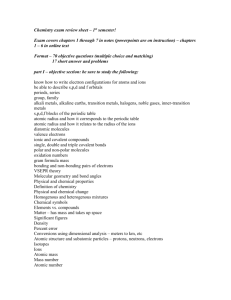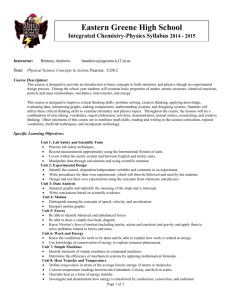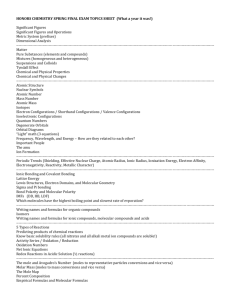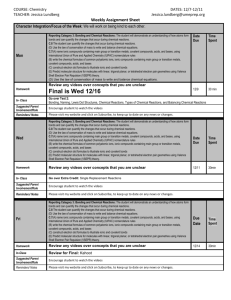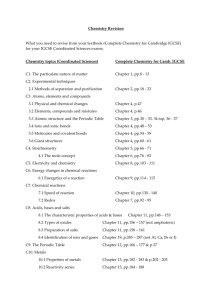Unit 1: Science Fundamentals
advertisement
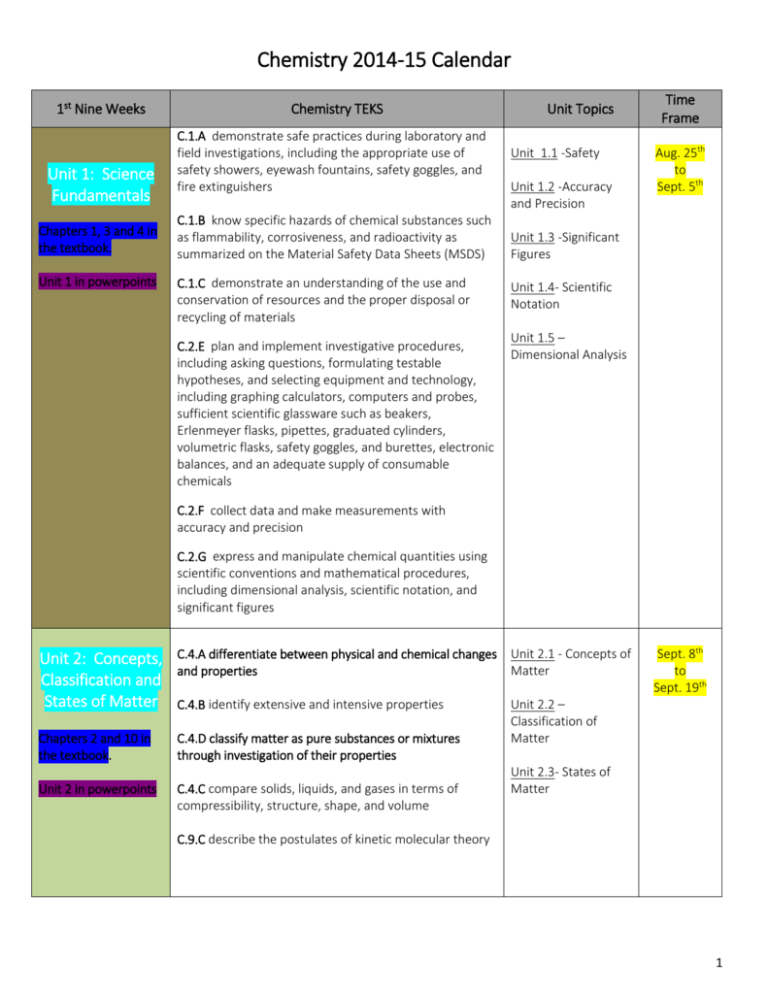
Chemistry 2014-15 Calendar 1st Nine Weeks Unit 1: Science Fundamentals Chapters 1, 3 and 4 in the textbook. Unit 1 in powerpoints Chemistry TEKS C.1.A demonstrate safe practices during laboratory and field investigations, including the appropriate use of safety showers, eyewash fountains, safety goggles, and fire extinguishers C.1.B know specific hazards of chemical substances such as flammability, corrosiveness, and radioactivity as summarized on the Material Safety Data Sheets (MSDS) C.1.C demonstrate an understanding of the use and conservation of resources and the proper disposal or recycling of materials C.2.E plan and implement investigative procedures, including asking questions, formulating testable hypotheses, and selecting equipment and technology, including graphing calculators, computers and probes, sufficient scientific glassware such as beakers, Erlenmeyer flasks, pipettes, graduated cylinders, volumetric flasks, safety goggles, and burettes, electronic balances, and an adequate supply of consumable chemicals Unit Topics Unit 1.1 -Safety Unit 1.2 -Accuracy and Precision Time Frame Aug. 25th to Sept. 5th Unit 1.3 -Significant Figures Unit 1.4- Scientific Notation Unit 1.5 – Dimensional Analysis C.2.F collect data and make measurements with accuracy and precision C.2.G express and manipulate chemical quantities using scientific conventions and mathematical procedures, including dimensional analysis, scientific notation, and significant figures Unit 2: Concepts, Classification and States of Matter C.4.A differentiate between physical and chemical changes Unit 2.1 - Concepts of and properties Matter Chapters 2 and 10 in the textbook. C.4.D classify matter as pure substances or mixtures through investigation of their properties Unit 2 in powerpoints C.4.B identify extensive and intensive properties C.4.C compare solids, liquids, and gases in terms of compressibility, structure, shape, and volume Sept. 8th to Sept. 19th Unit 2.2 – Classification of Matter Unit 2.3- States of Matter C.9.C describe the postulates of kinetic molecular theory 1 Unit 3: The Atom and Electrons in the Atom Chapter 5 in the textbook C.6.A understand the experimental design and conclusions used in the development of modern atomic theory, including Dalton’s Postulates, Thomson’s discovery of electron properties, Rutherford’s nuclear atom, and Bohr’s nuclear atom C.6.B understand the electromagnetic spectrum and the mathematical relationships between energy, frequency, and wavelength of light C.6.C calculate the wavelength, frequency, and energy of light using Planck’s constant and the speed of light C.6.D use isotopic composition to calculate average atomic mass of an element C.6.E express the arrangement of electrons in atoms through electron configurations and Lewis valence electron dot structures 2nd Nine Weeks Chemistry TEKS Unit 4: Periodic Table and Periodicity C.5.A explain the use of chemical and physical properties in the historical development of the Periodic Table Chapter 13 and 14 in the textbook. C.5.B use the Periodic Table to identify and explain the properties of chemical families, including alkali metals, alkaline earth metals, halogens, noble gases, and transition metals C.5.C use the Periodic Table to identify and explain periodic trends, including atomic and ionic radii, electronegativity, and ionization energy Unit 5: Bonding (Naming, formulas, VSEPR) Chapters 6,15 and 16 in the textbook C.7.A name ionic compounds containing main group or transition metals, covalent compounds, acids, and bases, using International Union of Pure and Applied Chemistry (IUPAC) nomenclature rules C.7.B write the chemical formulas of common polyatomic ions, ionic compounds containing main group or transition metals, covalent compounds, acids C.7.C construct electron dot formulas to illustrate ionic and covalent bonds C.7.D describe the nature of metallic bonding and apply the theory to explain metallic properties such as thermal and electrical conductivity, malleability, and ductility 3rd Nine Weeks C.7.E predict molecular structure for molecules with linear, trigonal planar, or tetrahedral electron pair geometries using Valence Shell Electron Pair Repulsion (VSEPR) theory Chemistry TEKS Unit 3.1- Atomic Theory Unit 3.2- Atomic Structure Sept. 22rd to Oct. 10th Unit 3.3- Isotopes and Average Atomic Mass Unit 3.4- Energy and Electromagnetic Radiation Unit 3.5- Calculating Energy, Wavelength, and Frequency Unit 3.6- Valence Electrons and Electron Configuration Unit 3.7- Lewis Electron Dot Structure Topics Unit 4.1Development of the periodic table Time Frame Oct. 20st to Nov. 7th Unit 4.2- Periodic Families and their properties Unit 4.3- Periodic Trends Unit 5.1- Naming Chemical Compounds Nov. 10th to Dec. 12th Unit 5.2- Writing Chemical Formulas Unit 5.3- Types of Bonds Unit 5.4- Molecular Geometry Topics Time Frame 2 Unit 6: Types of Reactions, Balancing, and Predicting Equations C.8.D use the law of conservation of mass to write and balance chemical equations Unit 6.1- Law of Conservation of Mass/Balancing Jan. 6th to Jan. 23th Unit 6.2- Types of Reactions Unit 6.3- Predicting Products Unit 7.1- The Mole Unit 7: The Mole and Stoichiometry C.8.A define and use the concept of a mole Unit 7.2- Molar Mass C.8.B use the mole concept to calculate the number of atoms, ions, or molecules in a sample of material Unit 7.3- Empirical and Molecular Formulas C.8.C calculate percent composition and empirical and molecular formulas C.8.E perform stoichiometric calculations, including determination of mass relationships between reactants and products, calculation of limiting reagents, and percent yield Jan. 26th to Feb. 20th Unit 7.4- Percent Composition Unit 7.5Stoichiometry Unit 7.6- Limiting Reagent Unit 7.7- Percent Yield Unit 8: Behaviors of Gases C.9.A describe and calculate the relations between volume, pressure, number of moles, and temperature for an ideal gas as described by Boyle’s law, Charles’ law, Avogadro’s law, Dalton’s law of partial pressure, and the ideal gas law C.4.C compare solids, liquids, and gases in terms of compressibility, structure, shape, and volume C.9.B perform stoichiometric calculations, including determination of mass and volume relationships between reactants and products for reactions involving gases Unit 8.1Introduction to Gas Laws Feb.23rd to Mar. 6th Unit 8.2- Boyle’s Law, Charles’ Law, and Combined Gas Law Unit 8.3- Ideal Gas Law, Avogadro’s Law, and Dalton’s Partial Pressure C.9.C describe the postulates of kinetic molecular theory 4th Nine Weeks Chemistry TEKS Topics Time Frame Unit 9: Aqueous Systems and C.10.A describe the unique role of water in chemical and biological Systems Unit 9.1- The Importance of Water Mar. 23rd to 3 Solutions Apr. 10th C.10.B develop and use general rules regarding solubility through investigations with aqueous solutions Unit 9.2- Types of Solutions C.10.C calculate the concentration of solutions in units of molarity Unit 9.3- Solubility and Solubility Rules C.10.D use molarity to calculate the dilutions of solutions Unit 9.4- Molarity and Dilutions C.10.E distinguish between types of solutions such as electrolytes and nonelectrolytes and unsaturated, saturated, and supersaturated solutions C.10.F investigate factors that influence solubilities and rates of dissolution such as temperature, agitation, and surface area C.10.H understand and differentiate among acid‐base reactions, precipitation reactions, and oxidation reduction reactions Unit 10: Acids and Bases C.7.A name ionic compounds containing main group or transition metals, covalent compounds, acids, and bases, using International Union of Pure and Applied Chemistry (IUPAC) nomenclature rules C.7.B write the chemical formulas of common polyatomic ions, ionic compounds containing main group or transition metals, covalent compounds, acids Unit 10.1- Naming Acids Apr. 13th to May 1st Unit 10.2- Acids and Bases Unit 10.3- Calculating pH C.10.G define acids and bases and distinguish between Arrhenius and Bronsted‐Lowry definitions and predict products in acid‐base reactions that form water C.10.H understand and differentiate among acid‐base reactions, precipitation reactions, and oxidation reduction reactions C.10.I define pH and use the hydrogen or hydroxide ion concentrations to calculate the pH of a solution C.10.J distinguish between degrees of dissociation for strong and weak acids and bases Unit 11: Thermochemistry C.11.A understand energy and its forms, including kinetic, potential, chemical, and thermal energies C.11.B understand the law of conservation of energy and Unit 11.1- Energy and Its Form Unit 11.2- Law of Conservation of May 4th to May 15th 4 the processes of heat transfer C.11.C use thermochemical equations to calculate energy changes that occur in chemical reactions and classify reactions as exothermic or endothermic C.11.D perform calculations involving heat, mass, temperature change, and specific heat C.11.E use Calorimetry to calculate the heat of a chemical process Unit 12: Nuclear Chemistry C.12.A describe the characteristics of alpha, beta, and gamma radiation C.12.B describe radioactive decay process in terms of balanced nuclear equations C.12.C compare fission and fusion reactions Energy and Heat Transfer Unit 11.3Thermochemical Equations Unit 11.4- Specific Heat Unit 11.5Calorimetry Unit 12.1- Types of Radiation and Nuclear Equations May 18th to May 30th Unit 12.2- Nuclear Fission, Fusion, and Half Life ****Note: this schedule is a guideline only and should be used as a general outline of the course. I will adjust the pacing of the course at my discretion (as the calendar date ends at May 30th). As we enter the 3rd nine weeks the textbook will change to a digital version of a newer textbook**** 5

